*NURSING > EXAM > Test Bank For Health Promotion Throughout the Life Span (Health Promotion Throughout the Lifespan (E (All)
Test Bank For Health Promotion Throughout the Life Span (Health Promotion Throughout the Lifespan (Edelman)) 8th Edition Chapter 1_25/SCORE A+
Document Content and Description Below
Table of Contents Accessibility Front Matter Dedication Contributors Reviewers Previous Contributors Preface Purpose of the Book Approach and Organization Key Features New Features Evolve Resources Fo... r Students For Instructors Acknowledgments Interactive Review – Health Promotion Throughout the Life Span Unit 1 Foundations for Health Promotion Interactive Review – Unit 1 Chapter 1 Health Defined: Objectives for Promotion and Prevention Objectives Key Terms THINK ABOUT IT: Use of Complementary and Alternative Therapies Exploring Concepts of Health Models of Health Clinical Model Role Performance Model Adaptive Model Eudaimonistic Model BOX 1-1 QUALITY AND SAFETY SCENARIO: Fall Prevention in the Home Questions Wellness-Illness Continuum High-Level Wellness FIGURE 1-1 Wellness-illness continuum with high-level wellness added. Moving from the center to the right demonstrates movement toward illness. Moving from the center to the left demonstrates movement toward health. Moving above the line demonstrates movement toward increasing wellness. Moving below the line demonstrates movement toward decreasing wellness. Health Ecology Functioning Health Illness, Disease, and Health Planning for Health Healthy People 2020 Goals BOX 1-2 DIVERSITY AWARENESS: Influence of Personal Cultural Values on Health Care Delivery BOX 1-3 INNOVATIVE PRACTICE: Process for Assessing, Evaluating, and Treating Overweight and Obesity in Adults Case Study Problem Identification Planning Interventions What Was the Actual Cause of Frank’s Problem? Evaluation of the Situation Levels of Prevention BOX 1-4 THE 13 FOCUS AREAS IN HEALTHY PEOPLE 2020 Primary Prevention BOX 1-5 HEALTHY PEOPLE 2020: Selected National Health Promotion and Disease Prevention Objectives for Nutrition and Weight Status Health Promotion The Theoretical Basis of Health Promotion The Social Nature of Health Promotion FIGURE 1-2 The three levels of prevention developed by Leavell and Clark. The Active and Passive Nature of Health Promotion An Application of Theory to the Practice of Health Promotion Specific Protection Examples BOX 1-6 HOT TOPICS: Health Promotion Program Incentives Secondary Prevention Tertiary Prevention The Nurse’s Role Nursing Roles in Health Promotion and Protection Advocate Care Manager Consultant Deliverer of Services Educator Healer Researcher Improving Prospects for Health Population Effects Shifting Problems BOX 1-7 RESEARCH FOR EVIDENCE-BASED PRACTICE: Preventing Functional Decline in Hospitalized Older Adults Moving Toward Solutions CASE STUDY: Health Assessment: Frank Thompson And Family Reflective Questions CARE PLAN: Health Assessment: Frank Thompson and Family Defining Characteristics Related Factors Expected Outcomes Interventions Summary References Pageburst Integrated Resources Chapter 2 Emerging Populations and Health Objectives Key Terms THINK ABOUT IT: A New Brand of Outreach for Chemically Dependent Homeless People Living with HIV/AIDS Health Disparities and Health Equality Emerging Populations in the United States BOX 2-1 HEALTHY PEOPLE 2020: Selected National Health Promotion and Disease Prevention Objectives for Emerging Populations Ethnicity, Ethnic Group, Minority Group, and Race Culture, Values, and Value Orientation BOX 2-2 DIVERSITY AWARENESS: Female Genital Mutilation: Taboo or Tradition Cultural Competency BOX 2-3 HOT TOPICS: Culturally Competent Care Among Nurses Folk Healing and Professional Care Systems Arab Americans Health Care Issues of Arab Americans Selected Health-Related Cultural Aspects FIGURE 2-1 (A, B) The Arab culture values prescribed rituals for praying and cultural dress. Asian Americans/Pacific Islanders Health Care Issues of Asian Americans/Pacific Islanders Selected Health-Related Cultural Aspects Latino/Hispanic Americans BOX 2-4 RESEARCH FOR EVIDENCE-BASED PRACTICE: Use of Complementary and Alternative Medicine (CAM) in the United States Health Issues of Latino/Hispanic Americans Selected Health-Related Cultural Aspects Blacks/African Americans Health Issues of Blacks/African Americans Selected Health-Related Cultural Aspects American Indians/Alaska Natives Health Care Issues of Native Americans Selected Health-Related Cultural Aspects The Emerging Rural and Urban Populations: Homeless Persons Homelessness: A Continuing Saga Why Families and Persons Become Homeless Health Issues of Homeless Persons and Families FIGURE 2-2 A homeless man works at a day labor job to earn some money. Strategies to Address Homelessness The Nation’s Response to the Health Challenge Healthy People 2020 Office of Minority Health Nursing’s Response to Emerging Populations and Health BOX 2-5 INNOVATIVE PRACTICE: Spiritual Practices and Health BOX 2-6 QUALITY AND SAFETY SCENARIO: Immigrants and Health Care Providers BOX 2-7 STUDENT HEALTH PROMOTION PROJECT CASE STUDY: An Older Immigrant Couple: Mr. and Mrs. Arahan Reflective Questions CARE PLAN: An Older Immigrant Couple: Mr. and Mrs. Arahan Defining Characteristics Related Factors Expected Outcomes Interventions Summary References Pageburst Integrated Resources Interactive Student Exercises Chapter 3 Health Policy and the Delivery System Objectives Key Terms THINK ABOUT IT: The Federal Health Care Reform Law The Health of The Nation Healthy People 2020 BOX 3-1 HEALTHY PEOPLE 2020: Overarching Goals for Healthy People 2020 Health Indicators of a Nation BOX 3-2 VULNERABLE POPULATIONS TABLE 3-1 INTERNATIONAL COMPARISONS OF CORE HEALTH INDICATORS FOR 2011 TABLE 3-2 INTERNATIONAL COMPARISON OF LIFE EXPECTANCY RATES (IN YEARS) OVER TIME FOR 1990, 2000, AND ESTIMATES OF 2011 FIGURE 3-1 Infant mortality rates for mothers ages 20 years and older by race/ethnicity and education, 2003 to 2005. TABLE 3-3 INFANT MORTALITY RATE IN THE UNITED STATES BY RACE/ETHNICITY, 2007 TABLE 3-4 INFANT MORTALITY RATES IN 2007, BY TRIMESTER IN WHICH PREGNANCY CARE WAS STARTED, SMOKING STATUS DURING PREGNANCY, AND EDUCATION OF MOTHER Historical Role of Women in Health Promotion A Safer System Global Health Historical Perspectives History of Health Care Early Influences Industrial Influences Socioeconomic Influences Public Health Influences Scientific Influences Special Population Influences Political and Economic Influences BOX 3-3 DIVERSITY AWARENESS: Health and Human Services Action Plan to Reduce Racial and Ethnic Health Disparities Community-Driven Approach to Reduce Health Disparities in the United States Split Between Preventive and Curative Measures Organization of The Delivery System Private Sector Independent Practice BOX 3-4 TYPES OF AMBULATORY CARE SETTINGS Move to Managed Care Health Maintenance Organizations BOX 3-5 A GLOSSARY OF MANAGED CARE TERMS Medicare Advantage Plans Independent Practice Associations Accountable Care Organizations BOX 3-6 HOT TOPICS: Medicare Advantage Plans Concierge Medical Practices Hospitalist Movement Point-of-Service Plans High-Deductible Health Insurance Plans Preferred Provider Organizations Public Sector FIGURE 3-2 Total health expenditure per capita, United States and selected countries, 2008. Source of Power Influence of Political Philosophy BOX 3-7 THE DEPARTMENT OF HEALTH AND HUMAN SERVICES (HHS) The Federal Public Health Service Agencies BOX 3-8 RESEARCH FOR EVIDENCE-BASED PRACTICE: Connecting Eligible Immigrant Families to Health Coverage and Care: Key Lessons from Outreach and Enrollment Workers, October 2011 Methodology Recommendations and Conclusions Current Health Policy BOX 3-9 SECTIONS OF THE AFFORDABLE CARE ACT Future Health Policy Nursing’s Role in Leading Change—2010 Recommendations of the IOM Report on the Future of Nursing Official Agencies Local Level BOX 3-10 INNOVATIVE PRACTICE: IOM’s October 5, 2010, Report on the Future of Nursing Recommendations State Level Federal Level Chief Nursing Officer Federal Emergency Management Agency (FEMA) Military Health Systems at the Federal Level Wounded Warrior Care Americans with Disabilities Federal Health Information Privacy Law International Level Voluntary Agencies The American Red Cross Financing Health Care Costs FIGURE 3-3 Growth in total health expenditure per capita, United States and selected countries, 1970 to 2008. Notes: Data for Canada, Norway, and Switzerland, are OECD estimates. Numbers are PPP-adjusted. Break in series: CAN (1995); SWE (1993, 2001); SWI (1995); UK (1997). Numbers are PPP-adjusted. Estimates for Canada and Switzerland in 2008. FIGURE 3-4 Total expenditure on health care as a share of GDP. Notes: Data from Australia and Japan are 2007 data. 2008 data from Belgium, Canada, Netherlands, Norway, and Switzerland are OECD estimates. 2000 numbers for Belgium are OECD estimates. Numbers are PPP-adjusted. Break in Series: AUS(1998); AUSTRIA(1990); BEL(2003, 2005); CAN(1995); FRA(1995); GER(1992); JAP(1995); NET(1998, 2003); NOR(1999); SPA(1999, 2003); SWE(1993, 2001); SWI(1995); UK (1997). Starting in 1993, Belgium used a different methodology. FIGURE 3-5 Total expenditure on health care as a share of the GDP. Note: Medicaid also includes other public programs: CHIP, other state programs, military-related coverage. Numbers may not add to 100% because of rounding. FIGURE 3-6 Nation’s health dollars, calendar year 2010: where it come from. Note: Sum of pieces may not equal 100% because of rounding. 1Includes worksite health care, other private revenues, Indian Health Service, workers’ compensation, general assistance, maternal and child health, vocational rehabilitation, Substance Abuse and Mental Health Services. 2Includes copayments, deductibles, and any amounts not covered by health insurance. Sources Employer Health Benefits FIGURE 3-7 Nation’s health dollars ($2.6 trillion), calendar year 2010: where it went. [Show More]
Last updated: 2 years ago
Preview 1 out of 219 pages
.png)
Buy this document to get the full access instantly
Instant Download Access after purchase
Buy NowInstant download
We Accept:

Reviews( 0 )
$16.50
Can't find what you want? Try our AI powered Search
Document information
Connected school, study & course
About the document
Uploaded On
Mar 07, 2022
Number of pages
219
Written in
Additional information
This document has been written for:
Uploaded
Mar 07, 2022
Downloads
0
Views
67

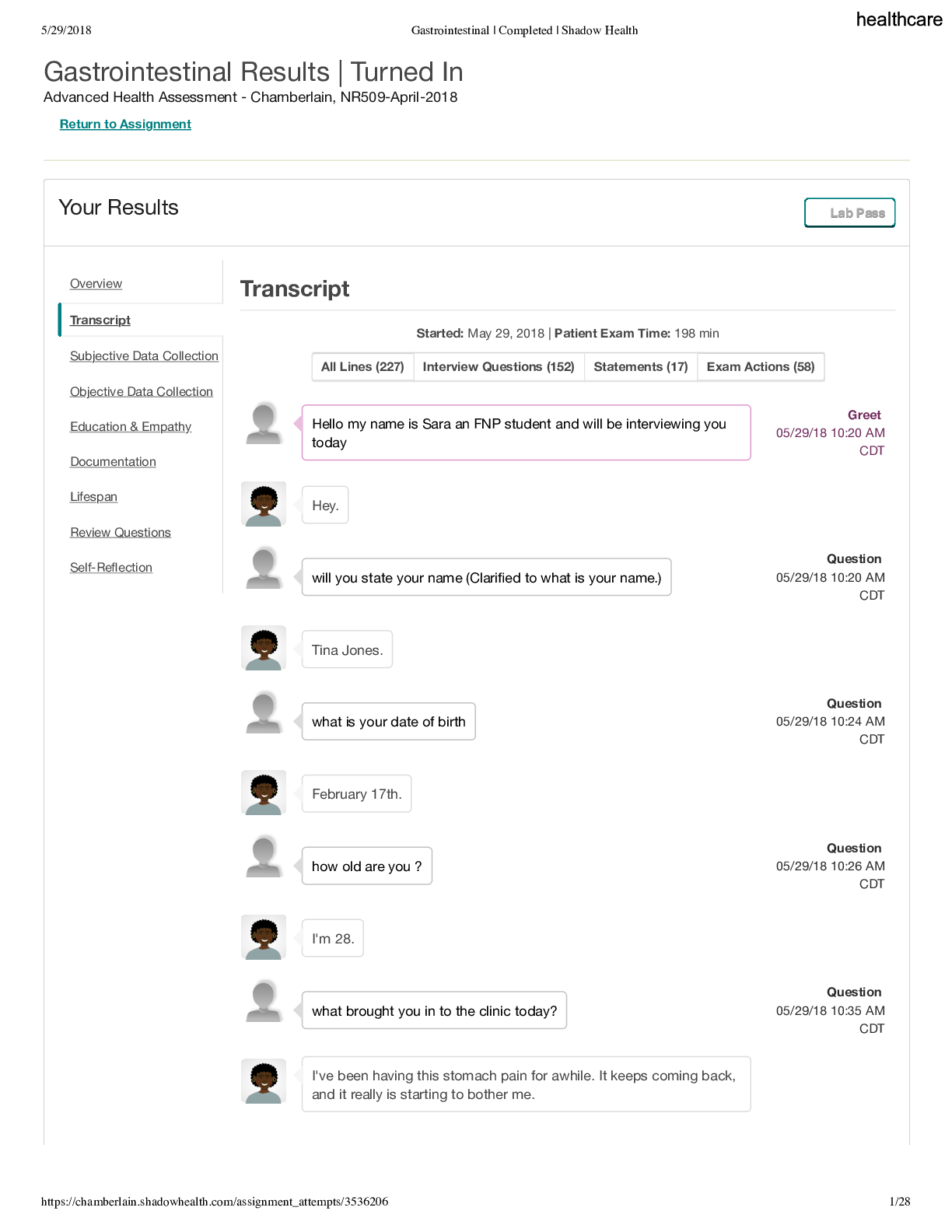
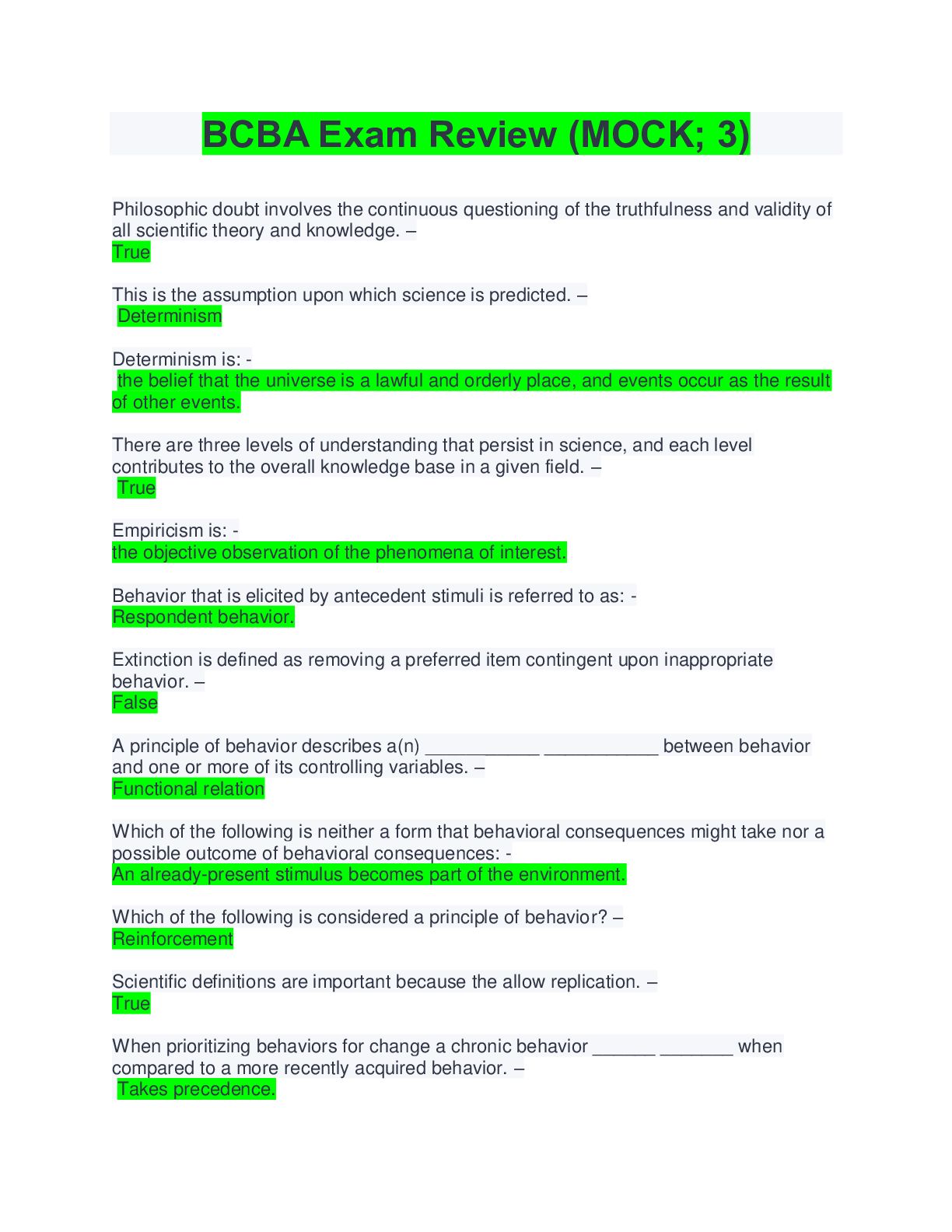
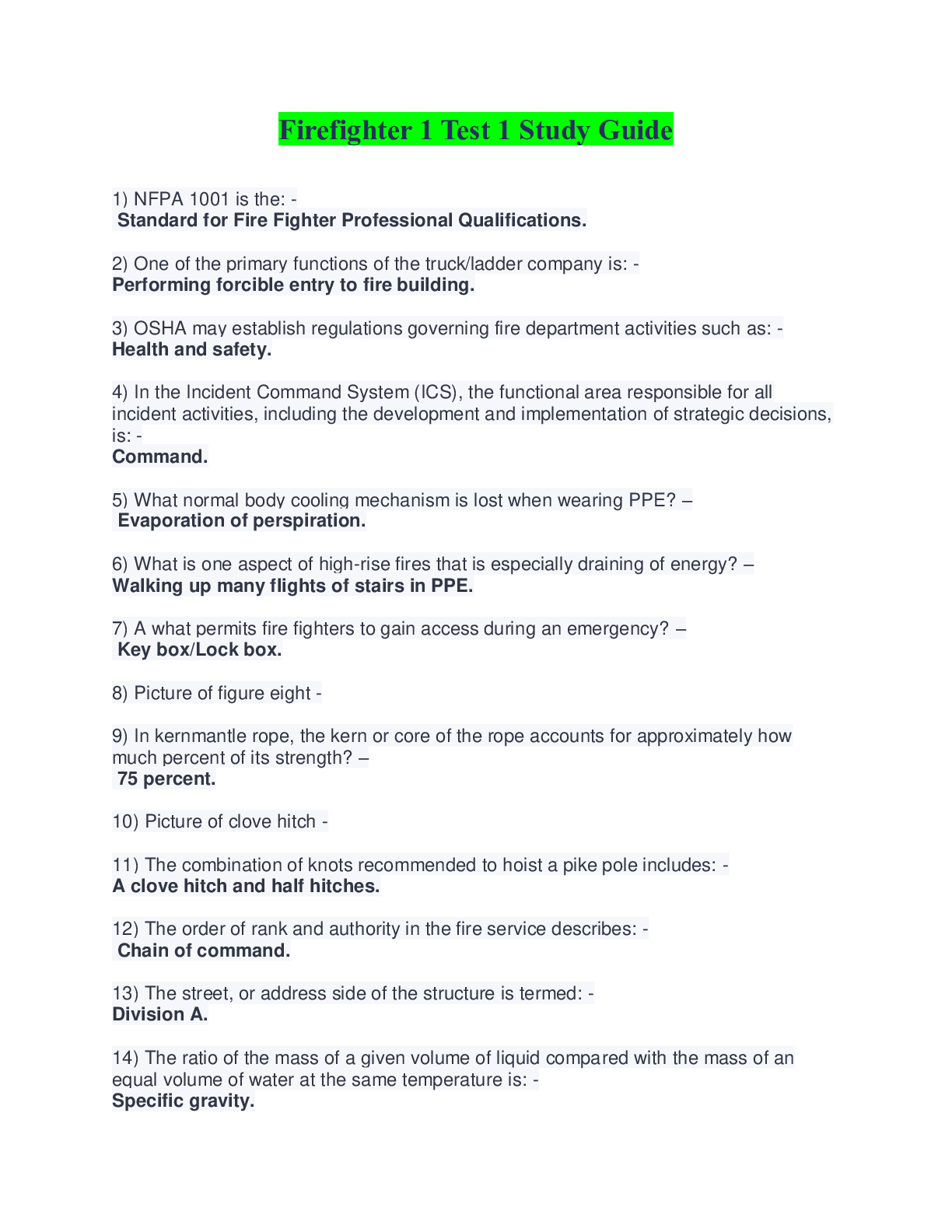
 (1).png)
 (1).png)
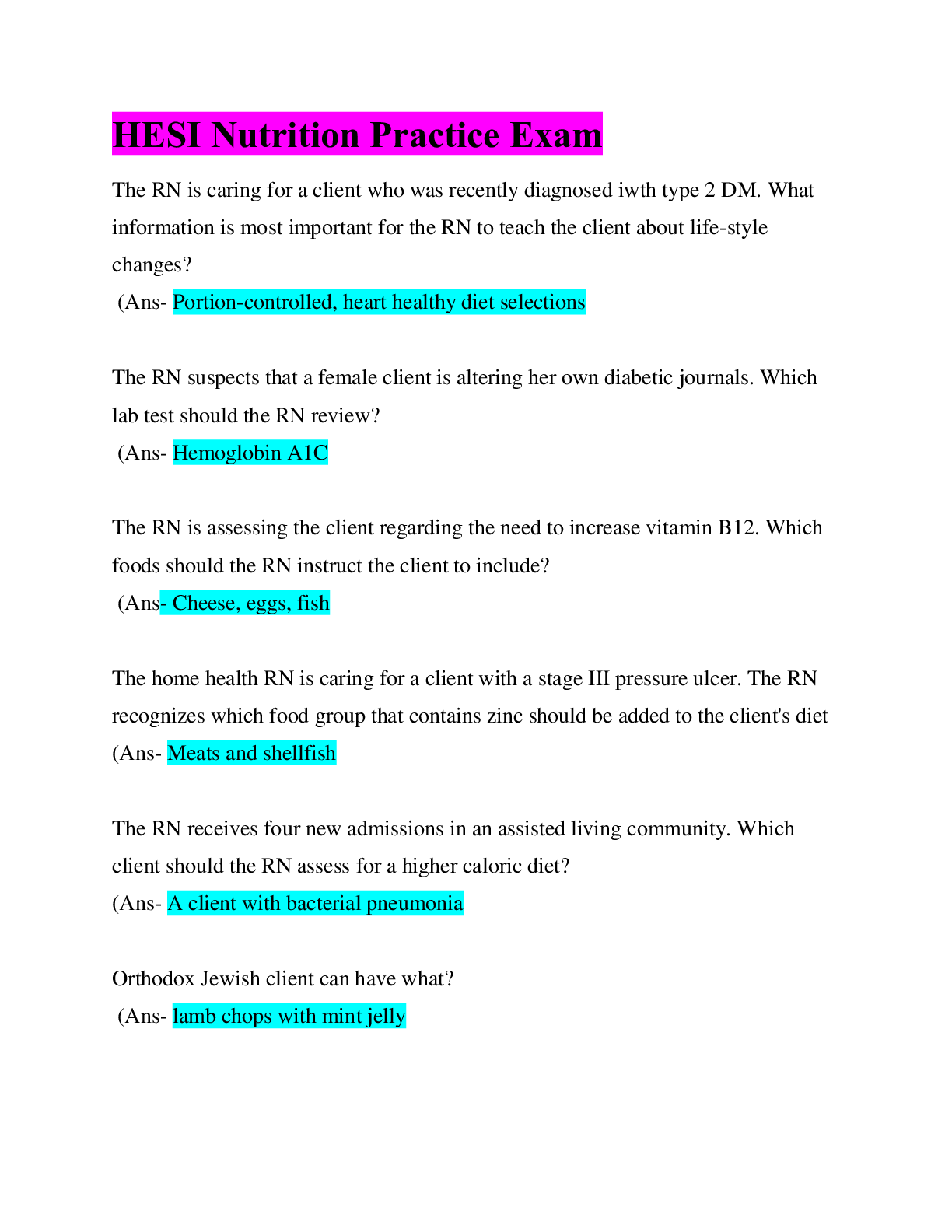
 (1).png)
 (1).png)
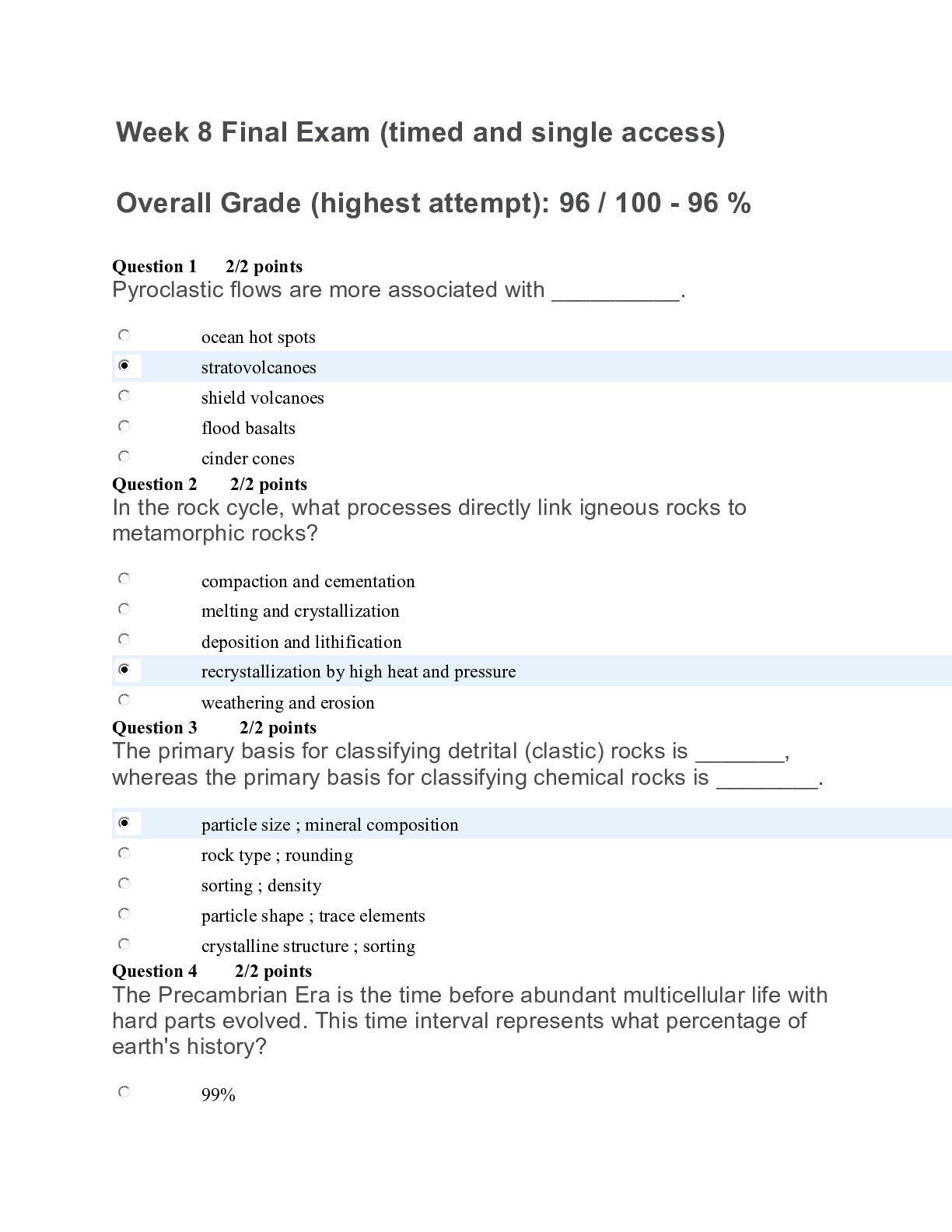
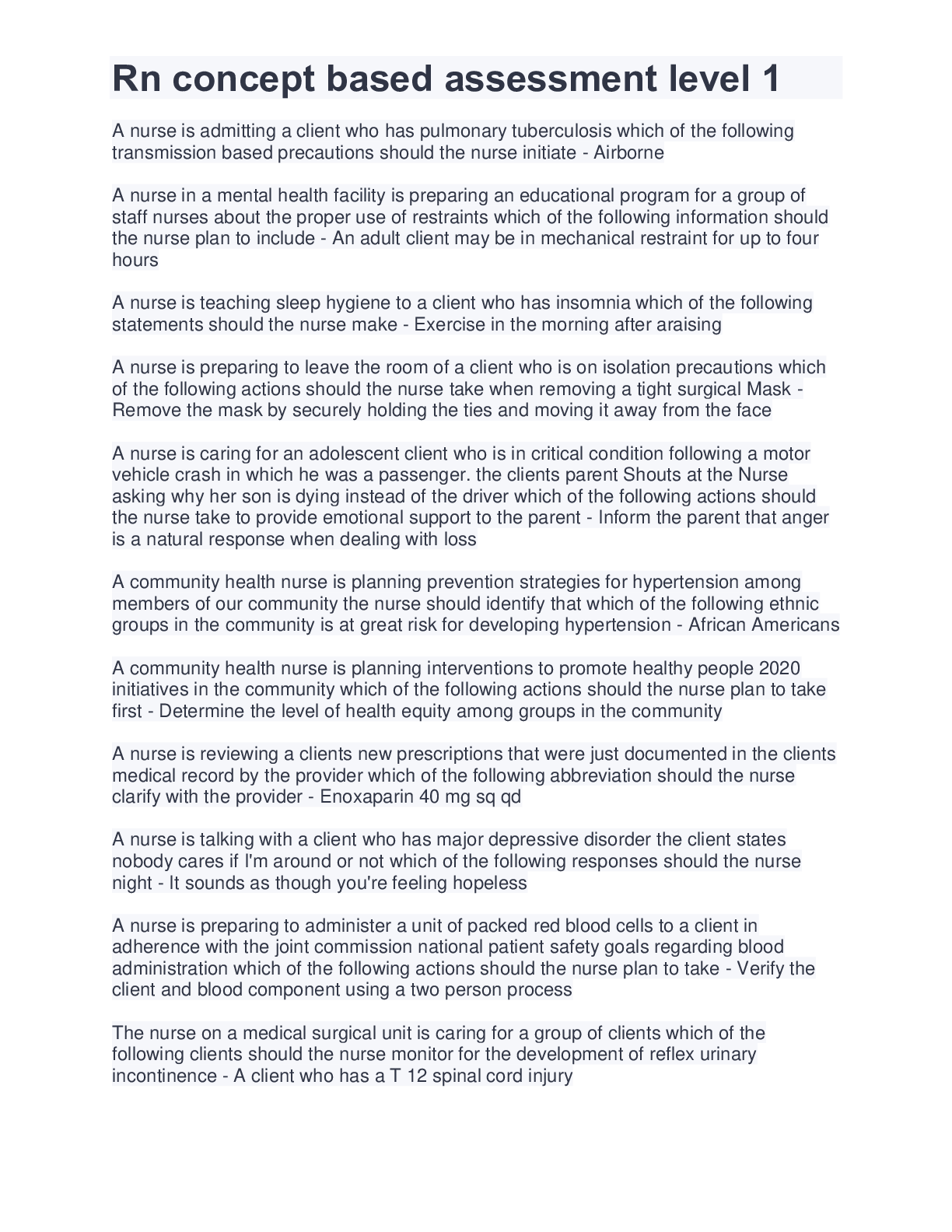
.png)
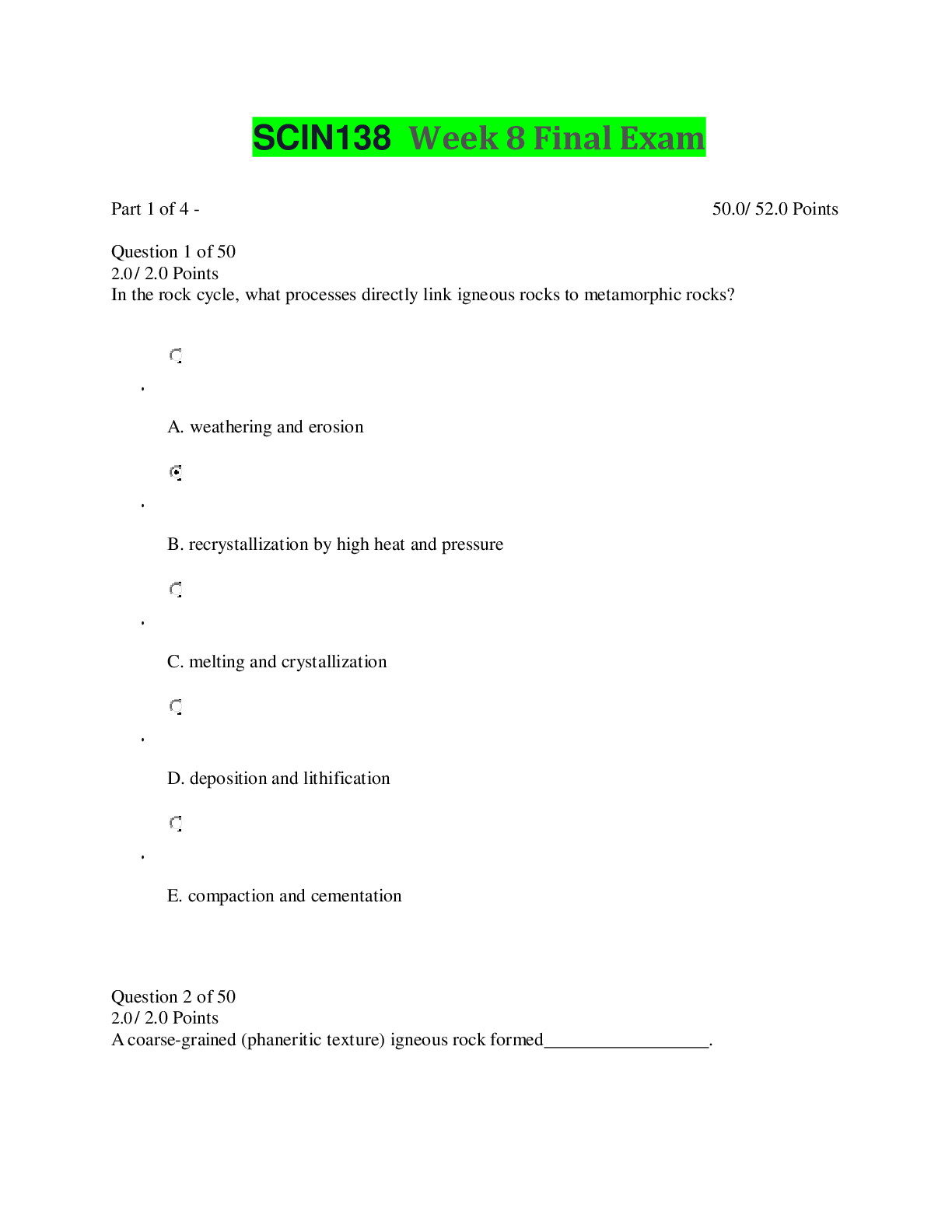

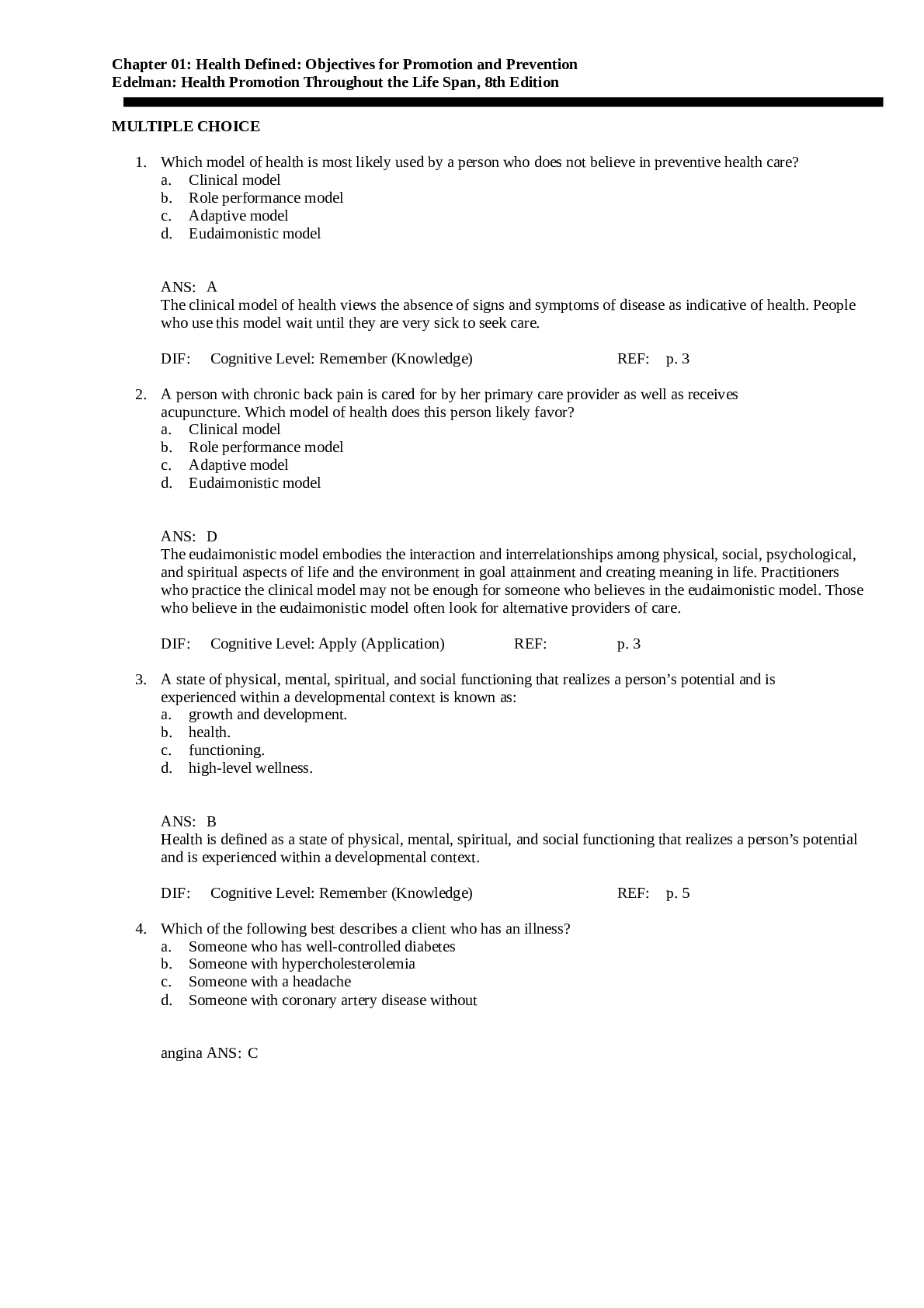
.png)

 (1).png)
.png)

